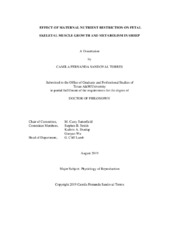| dc.description.abstract | Maternal nutrient restriction (NR) causes small for gestational age offspring (SGA), which exhibit a higher risk for metabolic syndrome. Skeletal muscle is among the most susceptible organs to maternal NR. Previous studies have typically considered NR fetuses as a single experimental group. However, using a sheep NR model, we routinely observe a spectral phenotype of fetal weights within the NR group, suggesting unique maternal-placental adaptations and fetal responses. Hence, studies were conducted to characterize particular aspects of fetal skeletal muscle growth and pathways for glucose uptake, while considering fetal weight variations within the NR group. Singleton pregnancies (n=56) were generated by embryo transfer. Ewes received 100% (Control, n=12) or 50% (NR, n=44) of NRC nutrient requirements from gestational day (GD) 35 until necropsy at GD 135, when gastrocnemius and soleus muscles were collected. NR fetuses were separated into quartiles based on fetal weight, the highest (Non-SGA, n=11) and lowest (SGA, n=11) quartiles were selected for investigation. Results for muscle growth showed decreased cross-sectional area in both muscles within NR(SGA) group compared to controls, without alterations in pathways for protein synthesis (MTOR) or degradation (Glucocorticoid-KLF15-ubiquitin ligases) regardless of upregulation in KLF15 (in gastrocnemius) and BCAT2 (in soleus) in NR(SGA) and NR(Non-SGA) fetuses. NR(SGA) group had decreased total content of amino acids, which suggests that lower availability of building blocks is a limiting factor for protein synthesis rate, without downregulating pathways involved in this process. Results for glucose uptake pathways showed an increase of insulin and IGF1 receptors in response to a decrease of those hormones, and higher content of the glucose transporters SLC2A4 and SLC2A1 in NR(SGA) fetuses within gastrocnemius. These metabolic adaptations would support fetal survival while predisposing for metabolic dysregulations in adulthood.
In both muscles, NR(SGA) group had lower type I myofiber proportion which if maintained postnatally would further affect metabolism. Collectively, these results highlight that while most responses within NR(SGA) group are concordant with previous observations for SGA offspring, our NR(Non-SGA) group represents a different phenotype that is not entirely protected from NR programming, despite being of normal fetal weight. Results also identify muscle-specific responses to maternal NR. | en |


